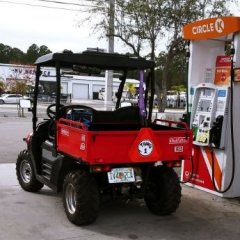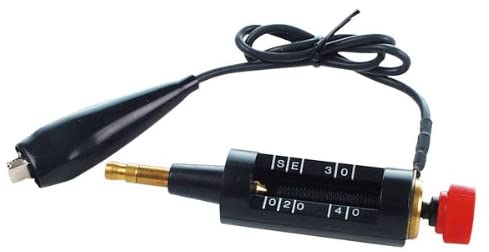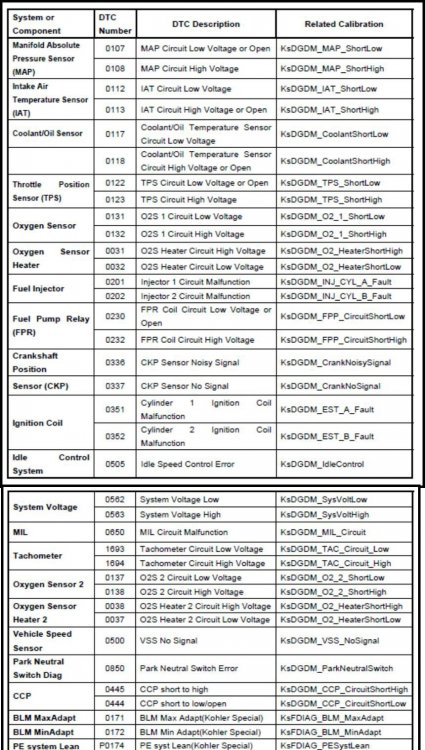-
Posts
350 -
Joined
-
Last visited
-
Days Won
49
Content Type
Profiles
Events
Forums
Gallery
Downloads
Community Map
Posts posted by cliffyk
-
-
On 1/26/2021 at 12:44 PM, MassBuck400 said:
OK I called Massimo Tech service. It is as I thought but I don't like it. There is a hex nut at the bottom of the dipstick. You have to remove the entire dipstick to fill wit oil.
Not a smart setup. It takes about 1.4 QT. of 10W30.
The "hex nut" is just an adapter for the "push-pull" dipstick--many motocycles, etc. have a screw-in dipstick as shown in the illustration Travis provided, Removing what you have is no big deal--however 'twas me, I'd get rid of it and get a screw-in dipstick that can be removed without tools--just for convenience' sake.
My Coleman (Hisun) Outfitter 400 has the more typical screw-in dipstick. I made an extended screw-in adapter (3D printed)--it's just a 3/4-10 thread:
To which I can connect a 1/2" ID hose and funnel when refilling the engine oil:
-
I'm pretty sure my neighbours don't even know what Stabil is--what I got out was "pinkish", but mostly clear jelly--a nearly perfectly "float bowl" shaped ring (minus the float) of he stuff...
-
ON my carburettor stuff that sits i generally drain the tank then run 'em 'til they stop. Next give a squirt or two of Marvel Oil from a pump can into the fuel line and crank it over as bit--fresh fuel when 'tis the season and they just pop right off...
-
 1
1
-
-
This damned ethanol contaminated gasoline they make us buy has a shelf life of about 3 months, unless in a very tightly sealed container¹--and that's here in FL were we have just 10% booze in the gas. On anything with carburettor that has been siting for more than 4 months the first hing to do is rebuild (or at least disassemble and clean) the carburettor. Lat Fall I repaired a number of "no-start" generators for my neighbours that had been improperly stored; they all had nasty jellied masses of pinkish crap in the float bowls. I've not found that any of the commonalty available "fuel stabilizers" prevents his--it's that blasted alcohol in the gas--maybe an olive or some vermouth would work--IDK?.
---------------------------------------------------------------------------------------------------
¹ - Take the spout off your gas cans and put on a good tight cap.
² - They just shut them off after last the hurricane season and let them sit for 9 months--they did not drain the fuel tank and run 'em dry--then put a cup or two of stabilizer in the tank and crank 'em over a couple times. -
20-years-old you got your money's worth...
-
 1
1
-
-
Made this today:
It's a tow-bar/eye for the front end:
The frame had the perfect place to mount such a thing,--a nice flat-faced robust crossbar with two 10 mm captive nuts:
So I used an 11' long piece of 2"x2"x1/4'hot roll angle iron to make a bolt-on towing eye (also good anchor point if using a snatch block for a double-line pull.
Painted up and installed:
Haven't used it yet but per my calculations it should be good to 12,000 to 15,000 lbs.
-
 1
1
-
-
On 12/30/2020 at 9:37 AM, Rustynutzz said:
I was wondering if anyone has plated one of these machines in any state. I'm in FL and am going to try to plate my T-Boss 550x Golf. Talked to a State Trooper who said it's absolutely plateable the way it sits and also talked to my insurance company and they said the same. I'm not sure what they will consider this type of machine, a golf cart or low speed vehicle. Their are different stipulations for both. I'll keep this thread updated once I get an inspection.
Unfortunately registering a UTV and getting a "tag" (Southern speak for license plate) in Florida is not possible as they are specifically excluded from highway use. He only way around this is to get it declared a Low Speed Vehicle which requires the MCO (Manufacturers Certificate of Origin) stating clearly : "This Vehicle Conforms To Federal Regulations Under Title 49 CFR 571.500 Standard N. 500 Low Speed Vehicles". This requirement is stated unambiguously in the Florida Department of Highway Safety and Motor Vehicles (FLDHSMV) (procedures manual TL-63) The MCOs for most ATVS and UTVs do not include this language. Additionally ATV and UTV MCOs usually have pastel colour background "security" lettering showing the document to be an OFF-HIGHWAY RECORD.
Beyond that, LSVS are limited (by conformity with CFR 49 571.500) to a maximum top speed of >+ 20 mph and <= 25 mph (though I've never had them test one)--a completely arbitrary requirement that could only have been conceived and accepted by dimwitted bureaucrats (Damn I hate Government).
I contacted both Coleman and Hisun about getting an MCO with the conformance statement and printed on security paper with out the "OFF-HIGHWAY RECORD..." background with no success. Of the two Hisun was the one most willing to discuss the subject--Coleman pretty much told me to "buzz-off"--The Hisun rep told me Hisun produces off-road "not for highway use" vehicles and does not want the liability of their being used on public roads.
Do you have the MCO for your T-Boss, what does it say? Does it have the OFF-HIGHWAY RECORD background? If so the FLDHSMV will just toss t back at you and say "tough luck"
Send me a PM if you'd like to discuss this further...
-
On 2/4/2021 at 8:26 AM, IslandHopper said:
If the engine is only cranking but not popping, backfiring etc. Then like T-Boss 410 said, the injector could be bad. Massimo does not have a inline fuel filter, just a screen. This apparently leads to a lot of bad injectors. A common bad injector symptom is the motor will start and idle but fall off under acceleration. In your case, there is nothing, so let’s look further.
Check the spark with a GOOD TESTER. I’ve been an equipment mechanic for 30+ years and I can’t tell you how many times I’ve seen a spark plug fire when laid on the engine block THEN NOT FIRE when it’s installed and under cylinder pressure.
Is the fuel fresh? In my shop it’s VERY common for flat fuel to cause a no start
If you truly have good spark and fresh fuel then try this quick trick.
Take the air filter off and shoot a little carb cleaner or starting fluid into the intake. Then crank the engine over....
1) Still nothing. You have a valve issue or a compression issue. (It’s not burning the fuel)2) Motor starts then dies. The Fuel Injector is most likely plugged or bad. (You’re not getting fuel into the cylinder)
I hope this helps.
^^^Good information^^^
A variable gap spark tester like this one cam detect he issue IslandHopper describes re; The plug firing under atmospheric pressure but not under compression.
Set the tester toa 8 to 10 mm gap--most modern ignition systems will fire across a 10 mm gap in free-air, if not the coil is likely weak...

-
Here's a YouTube video describing disassembly of the front differential, and some info re: how the 4WD solenoid works. THe guy is a hack, working on the floor--in a video presenting removal of the differential he uses a 16 oz. claw hammer.
-
I neglected to mention that they would also create a -10 % error in the speedometer--I.e. the speedometer displayed value will be 10% less than actual speed..
-
The switch, wiring, differential servo motor and/or differential gears are bad--repair/replace the bad component(s)...
I apologize for the terse response, however it's the best I can do given the information provided.
Does it (the front differential or anything related to 4WD make any noise when you operate the switch--KOEF (Key On Engine oFf)?
If not, have you checked the 4WD fuse (usually a 3 A device)?
-
!!!^^^THis^^^!!!
26/29 = 89.66...% That's how much of the original power will deliveerd to the ground--a 10.33% loss...
-
41 minutes ago, Jass said:
Thanks for the in out an help I’ll get this corrected and see how things go.
Unfortunately far too many aftermarket modifications are developed, produced and marketed by people with little to no actual engineering knowledge, skills or even ability who really do not know WTF they are doing ("lift-kits" other suspension "mods"seem especially prone to this failing)...
-
 1
1
-
-
I found a couple "rear-end" photos on the web of what are stated to be stock 2016 Mules:
Note the angle of the axles as compared to yours. Adjusting the preload of those poorly conceived aftermarket shocks will not correct that. The issue is the overall "eye-oi-eye" length of the shock--I would replace them with stock, or at least 1"-1-1/2" shorter units. However in comparing your and the OEM photos it seems as though the top mounting point of the aftermarket shocks is further outboard then the stock shocks (which would raise the suspension); it may be possible to move that top mounting point inward to the stock position and lessen the ridiculous angle of those axles.
Also, CV joints stop being constant velocity when operated at such extreme angles, whichj can (and usually does) lead to other problems with differential bearing and gears, an wheel bearings.
My idiot California nitwit step-son completely fouled up his 2017 Tacoma 4x4 by installing some cheap 6" lift-kit that was nothing but longer struts--screwed up the front and rear differentials, axle shafts and transmission due to the jarring dynamic loads created by the CV joints being at such extreme angles. The good kits relocated the differential housings downward to maintain a sensible axle angles.
-
 1
1
-
-
I am not familiar with the Mule, however the angle of those axle shafts seems quite extreme to me--at full extension they must be nearly vertical...
-
 1
1
-
-
17 minutes ago, Jass said:
Yes, and it has Elka suspension shocks on it and I’m thinking the CV shafts are at to much angle.
BINGO!--I read this in your first post " has a lift on it " and thought to myself--well there you go...
Contrary to popular web-based "fast &furious" opinion, and every now & then, the engineers that design this stuff actually do know what they are doing.
-
 2
2
-
-
On 12/4/2020 at 7:43 PM, kenfain said:
Aren't fault codes (if found), automatically displayed on the dashboard? Typically with other models, it'll blink a sequence to the dashboard clock, that's then decoded to provide the coresponding code.
But even if you find a code reader, I'd be surprised to see an OBD2 port. More likely it's a Delphi.
My 2020 Coleman Outfitter 400 claims to do this (though I've not had any problems to test it).
It's a pretty complete list (from the service manual):
-
-
18 minutes ago, Ryan Knuth said:
Thanks, that's super helpful. I was able to deduce that the starter is bad. Now onto another question: how does one find the starter?
Which measurement brought you there? Mostly curious, however we might be able to validate your conclusion...
Follow the heavy wire from the battery + post, to the starter solenoid, then from the solenoid to the starter...
-
The brake and "park" interlocks (if present) are most likely to be just switches wired in series with the "start"position of the ignition switch--as there is relatively little power required to activate the starter solenoid (a fancy word for relay) it would make no sense to use additional solenoids for those safety devices.
The first thing I would check would be the voltage across the battery terminal clamps, not the battery posts, but the cable clamps while attempting to crank the engine.
If the starter solenoid clicks and the observed voltage does not drop to 10.6 V or so then then it is probable the starter solenoid is bad--but don't rule out wiring or connections in the main supply to the starter motor just yet. If the voltage does drop to 10.6 V or so then the starter solenoid is good and the starter nay be seized up or otherwise bad.
To check the main supply path to the starter measure the voltage between the positive battery post (post, not cable clamp) and the positive terminal stud on the starter--while attempting to crank the motor.
In an ideal world it would be 0.0 V, however in our world 0.1 to 0.25 V would be normal. If more than 0.5 V then there is a bad wire, connection, or some other component in the path 'tween the battery and the starter. Next measure voltage between the battery + post and the next connection "back" from the starter (likely the starter solenoid output terminal)--while attempting to crank the motor. Is that 0.1 o 0.25 V? If it is then the wire between the solenoid output and the starter is bad (corroded or loose terminal or ???).
If not measure between the battery +post and the starter solenoid input post (again while cranking). If that is low (0.1 to 0.25 V) then the solenoid primary contacts are bad--replace the solenoid. If high (>0.5 V) the cable from the battery to the starter solenoid is bad--OR-next measure between the battery + post and cable clamp. If high (>0.5 V) than the cable clamp/battery connection is bad.
Or just disconnect, clean, and reconnect each connection between the battery and starter motor--don't just look at them to see if they "look OK", take them apart and clean them, reconect with a dose og dielectric grease (or any grease you have on hand--even Vaseline from the bedside table will work!).
-
10 hours ago, Travis said:
post some pictures if you can.
you'll probably need to remove the carburetor and clean it thoroughly.
^^^This^^^ 99.44% of the time now, with this damned ethanol gasoline, you'll find a jellied up ball of crap in the float bowl or diaphragm cavity if a diaphragm carb...
-
On 2/3/2021 at 9:14 PM, T-boss 410 said:
You should hear the fuel pump run for a few seconds when you turn the key to the run position. It's building up the pressure for starting the engine.
FWIW--This is how my Hisun HS400 works,,,
-
13 minutes ago, Travis said:
... canada's windmills operate in below zero temps and ice...
I interned for a manufacturer and lived in Montreal for 2 years--they would have to do so or not work at all. We had to plug our cars in at night (block heaters) so they would turn over (at all) in the morning...
-
22 minutes ago, T-boss 410 said:
Would some dielectric grease help?
Probably would, certainly wouldn't hurt. Super Lube's PTFE grease is commonly available--good for that and a whole bunch else--I use a couple tubes a year...



















Oil change
in UTV General Discussion
Posted
I'm printing a half-dozen of them now (takes 7-1/2 hours) the resin costs about $1 each, nothing else but wait, cleaning and final curing time; a 2¢ O-ring, and a tiny bit of electricity--if anyone is interested in one give me a yell--we'll work something out (an SASE or whatever)...